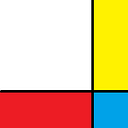Caravaggio: Baroque Dark Knight
米开朗基罗·梅里西·达·卡拉瓦乔(Michelangelo Merisi da Caravaggio)(1571–1610),意大利著名画家,也是一个传奇人物。1600年,他忽然出现在罗马艺术圈,但三天打鱼两天晒网,尽管如此却也不缺少佣金和资助。1606年,卡拉瓦乔与人争斗时杀死了一个年轻人,受到了年轻人的家人的追杀,于是他逃离罗马去到了马耳他。但在马耳他,卡拉瓦乔又卷入了另一场争斗,于是在1609年,他逃到了那不勒斯。在那不勒斯,他又遭到来历不明的追杀。最终1610年,卡拉瓦乔离开了人世。
Michelangelo Merisi da Caravaggio (Michelangelo Merisi da Caravaggio) (1571–1610), a famous Italian painter, is also a legend. In 1600, he suddenly appeared in the Roman art circle. Despite his low productivity of work, there was no shortage of commissions and subsidies. In 1606, Caravaggio killed a young man while fighting with others, and was chased by the young man’s family, so he fled Rome to Malta. But in Malta, Caravaggio was involved in another battle, so in 1609, he fled to Naples. In Naples, he has hunted down again from unknown sources. In 1610, Caravaggio passed away.
这位传奇人物,以画家的身份度过了人生最后十几年年,但也正是在这十几年里,他开创了暗色调主义(Tenebrism)。暗色调主义是指使用极为强烈的明暗对比,创造出一种聚光灯效果,以为画面增添戏剧性效果的绘画手法。其实,早在卡拉瓦乔之前,就有如丢勒,格雷考等画家开始使用明暗对比的作画手法,但卡拉瓦乔对明暗对比的使用更为强烈,甚至是激进,创造出一种前人不曾达到过的戏剧化效果,因而卡拉瓦乔被称为暗色调主义的开创者。
This legendary person spent the last ten years of his life as a painter, but during these ten years, he pioneered Tenebrism. Dark tonalism refers to a painting technique that uses powerful contrasts between light and dark to create a spotlight and add a dramatic effect to the picture. In fact, as early as Caravaggio, artists such as Dürer, Greco, and others began to use light and dark contrast painting techniques. Still, Caravaggio’s use of contrast is more intense, Or even radical, creating a dramatic effect that no one has ever achieved before, so Caravaggio is known as the pioneer of dark tone.
《朱迪斯斩杀赫罗弗尼斯》讲述的是罗马天主教和东正教圣经旧约中的一个故事。一支由赫罗弗尼斯统帅的亚述(Assyrian)军队攻陷了朱迪斯所在的城市。朱迪斯美丽机敏,她使用美色骗取了赫罗弗尼斯的信任。于是,在赫罗弗尼斯酒醉之后,她带着自己最信任的仆人进入了军营帐篷,将赫罗弗尼斯的头颅砍下。无人统帅的亚述军队就此落败,朱迪斯拯救了以色列人民。
“Judith Beheading Holofernes” tells a story in the Old Testament of the Roman Catholic and Orthodox Bibles. An Assyrian army commanded by Heronovis captured the city where Judith was located. Judith is beautiful and alert, and she uses beauty to deceive the trust of Herofinis. So, after Dr. Herofinis was drunk, she took her most trusted servant into the barracks tent and cut off Herofnis’ head. The Assyrian army without commander was defeated, and Judith saved the people of Israel.
这幅画展现了典型的卡拉瓦乔风格,也就是暗色调主义:卡拉瓦乔描绘了朱迪斯砍下赫罗弗尼斯头颅的瞬间,这一幕最为血腥,也因此具有视觉冲击力。他使用了黑色与深红色作为背景,营造出一丝神秘与紧张。深黑的背景与前景的人物,尤其是朱迪斯的白色上衣形成鲜明对比,仿佛有一束光照在了人物身上。这一技法的使用,让一幅画变为了一出舞台剧,画面紧张且具有动感。
This painting shows the typical Caravaggio style: dark tones: Caravaggio depicts the moment when Judith cut off the head of Herofinis. This scene is the most bloody and therefore has visual impact. He used black and crimson as the background, creating a trace of mystery and tension. The dark background is in sharp contrast with the foreground figures, especially Judith’s white top, as if a light beam is shining on the characters. This technique turns a painting into a stage play, and the picture is intense and dynamic.
这幅《圣马太的召唤》讲述的是耶稣基督召唤马太的瞬间。福音书告诫人们:“能认识到自己行为卑贱之人远胜过伪善之人”。马太是一个为政府收税而受到人们憎恶的税吏,他老实、憨厚,正是认识到“自己行为卑贱之人”,因此耶稣选择马太作为自己的门徒。
This “The Calling of Saint Matthew” is about the moment when Jesus Christ called Matthew. The Gospels warn people: “People who recognize their lowly behavior are far superior to hypocrisy.” Matthew is a tax collector who is hated by the people for collecting taxes from the government. He is honest and easy-going, and he realizes that he is “a humble person”, so Jesus chose Matthew as his disciple.
画面左侧,五名税吏围坐在桌子旁,似乎是在清点一天的收入。头戴羽毛帽的青年望着耶稣和使徒彼得,似是在用眼神询问,坐在青年旁边的马太一脸惊讶,指着自己,似乎是在问:“是我吗?”,马太旁边的两位税吏仍然在数钱,背对画面的青年侧过身体茫然地望着耶稣。画面右侧,使徒彼得侧过身子指向马太,似是在为耶稣介绍,耶稣指向马太似是在说:“是你,过来吧”。一束光从左侧射入画面,穿过耶稣头顶,打在了马太的脸上。这一光线的运用,创造出了名色调与暗色调的对比,再加上人物表情、动作塑造到位,使得画面具有极强的故事性及戏剧感。
On the left side of the screen, five tax collectors sitting around the table seem to be counting the day’s income. The young man wearing a feather hat looked at Jesus and the apostle Peter, and seemed to be asking with his eyes. Matthew sitting next to the young man looked surprised, pointing at himself, and seemed to be asking, “Is it me?”, Next to Matthew, The two tax collectors were still counting money, and the young man with his back to the picture looked at Jesus blankly. On the right side of the screen, the apostle Peter turned to point to Matthew, as if to introduce Jesus, and Jesus pointed to Matthew as if to say, “It’s you, come here.” A beam of light entered the picture from the left, passed through the top of Jesus’ head, and hit Matthew’s face. The use of this light creates a contrast between great tones and dark tones. Coupled with the expression and movement of characters, the picture has a strong story and drama.
